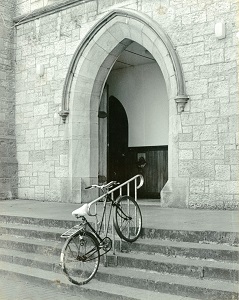GALWAY AUGUSTINIANS

by Tom Kenny
These are probably the best known and best worn set of steps in Galway. They were built in the 1855-59 period while the present Augustinian Church was being constructed. The site was slightly higher than the road level so the steps were required at the front and the back of the Church. The Augustinian connection with the city goes much further back than that.
They first came to Galway in 1508 when Margaret Athy, who was the wife of Mayor Stephen Lynch , founded a friary for them on the hill we now know as Forthill. This was just outside the walls and appears on early maps of Galway. In the 1550’s they lost the ownership of the church and cemetery to the Anglicans and they probably (for their own safety) moved into town. We know they administered to the tragic survivors of the Spanish Armada who were executed in the town and most likely buried in Forthill in 1588. A plaque in the graveyard commemorates the event and the generosity of the Galway women who saw to it that those sailors got a decent burial.
The Forthill site was important from a strategic point of view and there were renewed plans to fortify the city, so by 1602, the friary buildings and cemetery were levelled and a military fort built. After the 1641 insurrection, the city sided with the Catholic confederates, and in this new spirit, the fort was seen by the townspeople as a symbol of English dominance and persecution so it was razed to the ground and the Augustinians got back possession of their church.
This situation only lasted a few years. Unfortunately the prime situation of Forthill, and the increasing threat of the parliamentarians who were closing in on Galway, resulted in a mutual agreement between the Corporation and the Augustinians to demolish the remaining church and priory. In return, the corporation bound itself and its successors to build a similar church at its own cost on a named site when peace returned. After Cromwell expelled Catholics from the city, the friars managed to maintain an underground presence here.
In 1737 they has a house in Back Street (now Augustine St.) and in 1760, they built a new chapel beside it. It was to be the Augustinian centre of worship until 1855/59 when the present church was built. Since then, the church and the community have become a major part of the fabric of the city. One wonders how many people climbed the steps in our photograph on their way to attend services or to just have a quiet moment in the ‘Augie’.
In 1971 the friars were given a parish by Bishop Browne. John Power was the first parish priest, followed by John Murphy, John O’Shea, Flor O’Callaghan, Paddy O’Reilly, Dan Kelleher, Michael Leahy, Dick Lyng and John Hughes who is the current incumbent.
